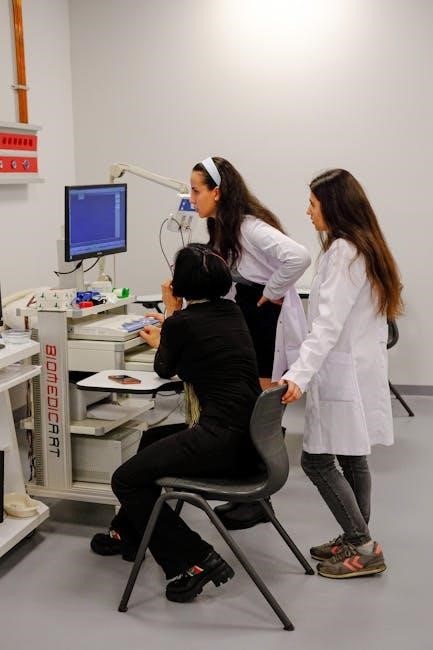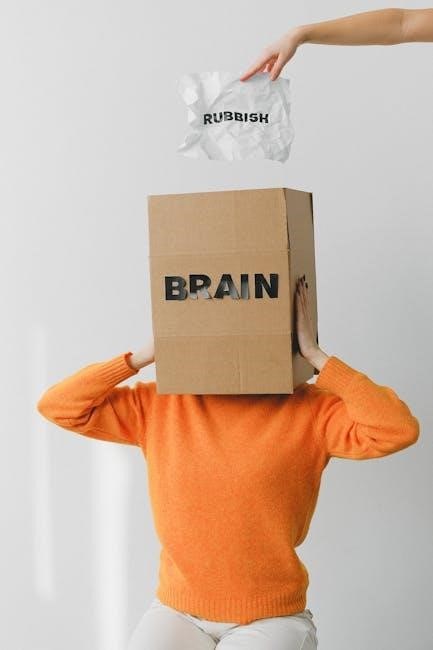Nursing Brain Sheets are essential tools for nurses, designed to organize and streamline patient information efficiently. They help in coordinating care and improving communication among healthcare teams effectively.
What is a Nursing Brain Sheet?
A Nursing Brain Sheet is a concise, organized document used by nurses to track and manage essential patient information. It typically includes patient demographics, medical history, medications, allergies, lab results, and vital signs. These sheets serve as quick reference tools, helping nurses prioritize tasks and ensure continuity of care. Often available as PDF templates, they can be customized for specific units, such as Med-Surg, ICU, or pediatrics. By providing a structured format, brain sheets enhance documentation accuracy and reduce the risk of errors, making them indispensable for effective patient care.
Importance of Brain Sheets in Nursing Practice
Nursing Brain Sheets are vital for efficient and accurate patient care. They provide a centralized, organized format for tracking critical patient data, ensuring that essential information is readily accessible. By standardizing documentation, brain sheets enhance care coordination and reduce errors. They also facilitate clear communication among healthcare teams, improving collaboration and patient outcomes. Additionally, these tools support time management, allowing nurses to focus on direct patient care. Available in PDF and customizable templates, brain sheets are adaptable to various clinical settings, making them indispensable for modern nursing practice and patient safety.

Key Elements of a Nursing Brain Sheet
A Nursing Brain Sheet includes patient demographics, medical history, current conditions, medications, allergies, lab results, and vital signs. These elements ensure comprehensive and organized patient documentation.
Patient Demographics and Identification
Patient demographics and identification are the foundation of a Nursing Brain Sheet, ensuring accurate and quick access to essential information. This section typically includes the patient’s name, medical record number, date of birth, and contact details. It also covers insurance information, emergency contacts, and primary caregiver details. Having this information readily available helps nurses and healthcare providers identify patients quickly and coordinate care effectively. Accurate demographics are critical for maintaining patient safety and streamlining communication across the healthcare team. This section is often the first in a brain sheet, setting the stage for organized patient documentation.
Medical History and Current Conditions
The Medical History and Current Conditions section of a Nursing Brain Sheet provides a comprehensive overview of a patient’s health background, including past illnesses, surgeries, and chronic conditions. It also details current diagnoses, ongoing treatments, and any significant medical events. This information is crucial for nurses to understand the patient’s health status and develop an appropriate care plan. By documenting past and present health issues, nurses can better anticipate potential complications and tailor interventions accordingly, ensuring comprehensive and personalized patient care.
Medications and Allergies
The Medications and Allergies section of a Nursing Brain Sheet is critical for tracking a patient’s current medications, dosages, frequencies, and administration routes. It also documents known drug allergies, including specific reactions. This section ensures nurses are aware of potential interactions and sensitivities, preventing adverse events. By listing PRN medications and antibiotics, it aids in timely decision-making. Accurate documentation here enhances patient safety and ensures adherence to treatment plans. This section is vital for maintaining continuity of care and avoiding medication errors.
Laboratory Results and Vital Signs
Laboratory Results and Vital Signs are a cornerstone of Nursing Brain Sheets, enabling nurses to monitor patient health and detect trends. This section includes recent lab values, such as blood work, imaging, and other diagnostic tests, alongside normal ranges for quick reference. Vital signs like blood pressure, heart rate, oxygen saturation, and temperature are also documented to track patient stability. Including timestamps helps identify patterns and changes over time. This data is crucial for assessing patient conditions, guiding care decisions, and ensuring timely interventions. Accurate documentation here supports effective care coordination and patient safety.

Popular Nursing Brain Sheet Templates
Popular Nursing Brain Sheet templates include Med-Surg, ICU, and Pediatric designs, offering structured formats for efficient documentation and customization to meet specific unit needs.
Med-Surg Nursing Brain Sheet
A Med-Surg Nursing Brain Sheet is a versatile tool designed for medical-surgical units, helping nurses track vital patient information efficiently. It typically includes sections for demographics, medical history, medications, lab results, and vital signs. Customizable to meet specific patient needs, it allows nurses to prioritize care and document progress effectively. The template often includes space for notes on treatments, dietary plans, and discharge instructions. Its organized format ensures clarity and reduces errors, making it a popular choice for nurses in fast-paced environments. This brain sheet is widely used for its ability to streamline workflow and enhance patient care coordination.
ICU and Critical Care Brain Sheet
An ICU and Critical Care Brain Sheet is a specialized tool designed for high-acuity patient management. It includes detailed sections for vital signs, ventilator settings, and medication titrations, ensuring precise documentation. Critical lab values, such as arterial blood gases and electrolytes, are prominently featured. The sheet often includes space for tracking neurological assessments, fluid balances, and hemodynamic data. Customizable to meet the unique needs of critically ill patients, it helps nurses prioritize interventions and communicate effectively with the interdisciplinary team. This tool is indispensable for managing complex cases and ensuring seamless care in intensive settings.
Pediatric and Maternal Nursing Brain Sheet
A Pediatric and Maternal Nursing Brain Sheet is tailored for specialized care in neonatal, pediatric, and maternal health settings. These sheets include sections for growth charts, vaccination schedules, and developmental milestones for pediatric patients, while maternal sheets focus on prenatal, labor, and postpartum data. They incorporate space for tracking feeding patterns, diaper output, and vital sign trends in infants. For maternal care, details on fetal heart rates, contractions, and post-delivery recovery are emphasized. Designed to address unique patient needs, these brain sheets enhance care coordination and ensure comprehensive documentation in dynamic environments.

Benefits and Advantages of Using Brain Sheets
Nursing Brain Sheets enhance patient care coordination, improve communication among healthcare teams, and reduce errors by organizing critical patient information in an accessible format for nurses.
Improved Patient Care Coordination
Nursing brain sheets significantly enhance patient care coordination by centralizing critical information, ensuring all healthcare team members are aligned. They streamline the tracking of patient histories, medications, lab results, and vital signs, reducing fragmentation. This organized approach allows nurses to quickly access essential data, facilitating timely interventions and consistent care delivery. By maintaining a comprehensive overview of patient needs, brain sheets promote seamless transitions between shifts and departments, ensuring continuity of care. This coordination is vital for delivering high-quality, patient-centered outcomes and meeting complex healthcare demands effectively.
Enhanced Communication Among Healthcare Teams
Nursing brain sheets act as a standardized reference point, fostering clear and consistent communication among healthcare providers; By organizing patient data in a concise format, they ensure that all team members access the same information, reducing misunderstandings. Tools like SBAR (Situation, Background, Assessment, Recommendation) can be integrated into brain sheets, further enhancing handoffs and collaborative decision-making. This streamlined communication is particularly crucial during shift changes or patient transfers, ensuring continuity of care. Brain sheets also serve as a visual aid, making complex patient information easily digestible and promoting effective teamwork, ultimately leading to better patient outcomes and safer care practices.
Reduced Risk of Errors in Patient Care
Nursing brain sheets significantly minimize errors by providing a structured format for documenting critical patient information. By organizing data such as medications, lab results, and vital signs in one place, they ensure that essential details are not overlooked. This clear and concise presentation helps nurses quickly identify potential issues, such as medication allergies or abnormal lab values, during patient care. The use of standardized templates also reduces transcription errors and miscommunication, ensuring that all healthcare providers are on the same page. This consistency leads to safer, more accurate care delivery and better patient outcomes overall.

How to Create a Custom Nursing Brain Sheet
Creating a custom nursing brain sheet involves reviewing templates, identifying essential sections, and using design tools to ensure clarity and organization for effective patient care.
Steps to Design Your Own Template
Start by assessing your nursing needs and goals. Choose a format, such as PDF, for easy accessibility. Include key sections like patient demographics, medications, and lab results. Use design tools like Canva or Excel to create a clean layout. Test the template with real patient scenarios to ensure functionality. Gather feedback from colleagues to refine it. Finally, save and share your custom brain sheet for team use, ensuring it remains adaptable to different patient care situations.
Tools and Software for Brain Sheet Creation
Designing nursing brain sheets is made easier with tools like Canva, Excel, and Google Drive. Canva offers templates for visually appealing layouts, while Excel provides customizable spreadsheets. Google Drive allows real-time collaboration and easy sharing. PDF editors like Adobe Acrobat are useful for creating and editing printable formats. Additionally, platforms like NRSNG.com offer pre-designed templates that can be tailored to specific needs. These tools help nurses create organized, efficient, and adaptable brain sheets, ensuring patient information is clear and accessible.
Nursing brain sheets are invaluable tools for organizing patient care, enhancing communication, and reducing errors. Their widespread use and availability in PDF formats make them indispensable for modern nursing practice.
Final Thoughts on Nursing Brain Sheets
Nursing brain sheets are indispensable tools for modern nursing practice, offering a structured approach to patient care. They simplify documentation, reduce errors, and enhance care coordination. With numerous free templates available in PDF format, nurses can easily customize them to meet specific needs. Their popularity continues to grow, as they provide a concise and organized way to track vital patient information. Whether for med-surg, ICU, or pediatric care, brain sheets remain a vital resource for nurses striving to deliver high-quality, patient-centered care efficiently.
Future Trends in Nursing Documentation
The future of nursing documentation lies in digital integration and accessibility; Brain sheets in PDF format are becoming increasingly popular due to their ease of use and customization. As technology advances, nurses can expect more interactive and cloud-based templates, allowing seamless sharing and updates. Artificial intelligence may also play a role, automating data entry and providing real-time insights. Mobile-friendly brain sheets will enable nurses to access critical patient information on the go. These innovations will enhance efficiency, reduce errors, and improve patient outcomes, ensuring brain sheets remain a cornerstone of nursing practice for years to come.
